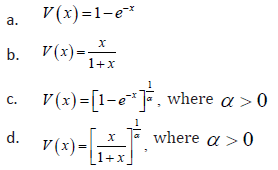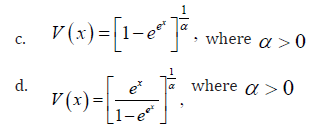Further Developments on the T-Transmuted X Family of Distributions
Clement Boateng Ampadu1* and Girish Babu2
131 Carrolton Road, Boston, MA 02132-6303, USA
2Department of Statistics, Government Arts and Science College, India
Submission: April 12, 2018; Published: July 09, 2018
*Corresponding author: Clement Boateng Ampadu, 31 Carrolton Road, Boston, MA 02132-6303, USA; Email: drampadu@hotmail.com
How to cite this article: Clement B A, Girish B. Further Developments on the T-Transmuted X Family of Distributions. Biostat Biometrics Open Acc J. 2018; 7(4): 555720. DOI: 10.19080/BBOAJ.2018.07.555720
Abstract
We review the T-Transmuted Family of Distributions introduced in [1] and propose some further developments of this class of distributions.
Keywords: T-X(W) family of distributions; Transmuted family of distributions; Biological data; Health data; Quadratic rank; Transmutation map; Monotonic; Beta-generated; Random variable; Integral representation; Base distribution; Plethora; Probability distributions; Quantile function
Introduction
Transmuted family of distributions
According to the quadratic rank transmutation map (QRTM) approach in [2], the CDF of the transmuted family of distributions is given by

Where −1≤λ≤1 and G(x)c is the CDF of the base distribution. When 0λ= we get the
CDF of the base distribution
Remark 1.1. The PDF of the transmuted family of distributions is obtained by differentiating the CDF above.
A plethora of results discussing properties and applications of this class of distributions have appeared in the literature, and for examples see [3]
T-X(W) family of distributions
This family of distributions is a generalization of the beta-generated family of distributions first proposed by Eugene et.al [4]. In particular, let r(t) be the PDF of the random variable T∈[a,b] ,−∞≤a< b ≤∞ and let ()()WFx be a monotonic and absolutely continuous function of the CDF F(x) of any random variable .X The CDF of a new family of distributions defined by Alzaatreh et.al [5] is given by

Where R(⋅) is the CDF of the random variable T and a≥0
Remark 1.2. The PDF of the T-X(W) family of distributions is obtained by differentiating the CDF above
Remark 1.3. When we set  then we use the term “T-X Family of Distributions” to describe all sub-classes of the T-X(W) family of distributions induced by the weight function W(x)=−ln(1-x) A description of different weight functions that are appropriate given the support of the random variable T is discussed in [5]. A plethora of results studying properties and application of the T-X(W)family of distributions have appeared in the literature, and the research papers, assuming open access, can be easily obtained on the web via common search engines, like Google, etc.
then we use the term “T-X Family of Distributions” to describe all sub-classes of the T-X(W) family of distributions induced by the weight function W(x)=−ln(1-x) A description of different weight functions that are appropriate given the support of the random variable T is discussed in [5]. A plethora of results studying properties and application of the T-X(W)family of distributions have appeared in the literature, and the research papers, assuming open access, can be easily obtained on the web via common search engines, like Google, etc.
T-Transmuted X family of distributions
This class of distributions appeared in [1]. In particular the CDF admits the following integral representation for a≥0

Where r(t) is the PDF of the random variable T and F(x) is the transmuted CDF of the random variable ,X that is,

Where −1≤λ≤1 and G(x)c is the CDF of the base distribution.
Remark 1.4. The PDF of the T-Transmuted Xfamily of distributions is obtained by differentiating the CDF above.
Further developments
In this section, inspired by quantile generated probability distributions [6], we propose some new extensions of the T-Transmuted X family of distributions. We give the CDF of these new class of distributions, only in integral form. However, the CDF and PDF can be obtained explicitly by applying Theorem 2.2 and Theorem 2.3, respectively [7].
The qT X− family of distributions
Definition 2.1. Let V be any function such that the following holds:
I.
II. F(x) is differentiable and strictly increasing
III.  and
and  then the CDF of the qT X− family induced by V is given by
then the CDF of the qT X− family induced by V is given by

Where  is the quantile density function of random variable [],,Tab∈ for ,ab−∞≤<≤∞ and F(x) is the CDF of any random variable X.
is the quantile density function of random variable [],,Tab∈ for ,ab−∞≤<≤∞ and F(x) is the CDF of any random variable X.
Theorem 2.2. The CDF of the qT X−c family induced by V is given by
K(x)=Q[V(k(x))]
Proof. Follows from the previous definition and noting that

Theorem 2.3. The PDF of the qT X− family induced by V is given by

Proof. ,k=K′, F′=f, and K is given by Theorem 2.2
F′=f, and K is given by Theorem 2.2
Remark 2.4. When the support of T is [a,∞) where a≥0, we can take V as follows

Remark 2.5. When the support of T is (−∞,∞) we can take V as follows


Some qT transmuted X family of distributions
In what follows we assume the random variable T has PDF r(t) and quantile function Q(t) We also assume the random variable X has transmuted CDF 
Where −1≤λ≤1 and G(x) is the CDF of the base distribution.
Families of qT transmuted X distributions of Type I
The CDF has the following integral representation for α>0 and α≥0

Families of qT transmuted X distributions of Type II
The CDF has the following integral representation for 0α> and 0α≥

Families of qT transmuted X distributions of Type III
The CDF has the following integral representation for α>0

Concluding Remarks
Our hope is that researchers will find these class of distributions practically significant in modeling biological data, health data, etc. We hope the researchers will further develop the properties and applications of these new class of distributions.
References
- Jayakumar K, Girish Babu M (2017) T-Transmuted X Family of Distributions. Statistica 77: 3
- Shaw W, Buckley I (2007) The alchemy of probability distributions: beyond Gram-Charlier expansions, and a skew-kurtotic-normal distribution from a rank transmutation map. Research report.
- Faton Merovci, Ibrahim Elbatal (2014) Transmuted Weibull-geometric distribution and its applications, Scientia Magna 10(1): 68-82
- Eugene N, Lee C, Famoye F (2002) The beta-normal distribution and its applications. Communications in Statistics-Theory and Methods 31(4): 497-512.
- Alzaatreh A, Lee C, Famoye F (2013) A new method for generating families of continuous distributions. Metron 71(1): 63-79.
- Clement Boateng Ampadu (2018) Quantile-generated family of distributions: a new method for generating continuous distributions. Fundamental Journal of Mathematics and Mathematical Sciences 9(1): 13-34.
- Muhammad S, Robert K, Irene Le (2016) Transmuted Gompertz Distribution: Properties and Estimation. Pak J Statist 32(3): 161-182.






























